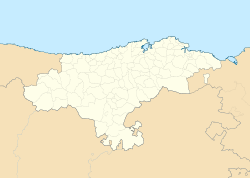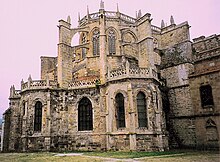
Cantabria is an autonomous community and province in northern Spain with Santander as its capital city. It is called a comunidad histórica, a historic community, in its current Statute of Autonomy. It is bordered on the east by the Basque autonomous community, on the south by Castile and León, on the west by the Principality of Asturias, and on the north by the Cantabrian Sea, which forms part of the Bay of Biscay.
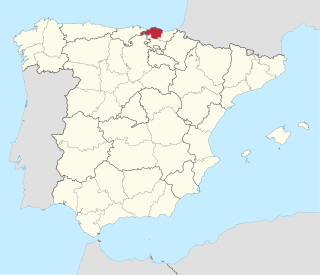
Biscay or Bizkaia, is a province of the Basque Autonomous Community, heir of the ancient Lordship of Biscay, lying on the south shore of the eponymous bay. The capital and largest city is Bilbao.

Basque nationalism is a form of nationalism that asserts that Basques, an ethnic group indigenous to the western Pyrenees, are a nation and promotes the political unity of the Basques, today scattered between Spain and France. Since its inception in the late 19th century, Basque nationalism has included Basque independence movements.

Labourd is a former French province and part of the present-day Pyrénées Atlantiques département of Nouvelle-Aquitaine region. It is one of the traditional Basque provinces, and identified as one of the territorial component parts of the Basque Country by many, especially by the Basque nationalists.

The Kingdom of Navarre, originally the Kingdom of Pamplona occupied lands on both sides of the western Pyrenees, with its northernmost areas originally reaching the Atlantic Ocean, between present-day Spain and France.

Aranda de Duero is a city and municipality, capital of the Ribera del Duero comarca, in the south of the province of Burgos, in Castile and León, Spain. It has a population of roughly 33,000 people and lies on the River Duero.

Balmaseda is a town and municipality located in the province of Biscay, in the Basque Country. Balmaseda is the capital city of the comarca of Enkarterri, in western Biscay and serves an important role in the province thanks to its proximity to the capital city of Bilbao and the regions of Cantabria and Castile and León.
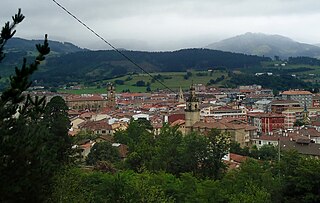
Durango is a town and municipality of the historical territory and province of Biscay, located in the Basque Country, Spain. It is the main town of Durangaldea, one of the comarcas of Biscay. Because of its economical activities and population, Durango is considered one of the largest towns in Biscay after the ones that compose the conurbation of Greater Bilbao.

Cuéllar is a municipality in the Province of Segovia, within the autonomous community of Castile and León, Spain.
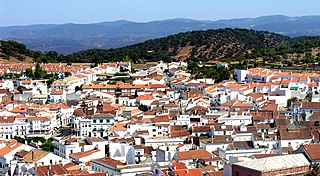
Aracena is a town and municipality located in the province of Huelva, southwestern Spain. As of 2012, the city has a population of 7,814 inhabitants. The town derived its name from the Sierra de Aracena, which is part of the Sierra Morena system.

BizkaiBus is the name for bus services serving the province of Biscay, Spain. It is named after the Basque name of the province, Bizkaia. The buses can be identified by their distinctive green livery.

The Basques are an indigenous ethno-linguistic group mainly inhabiting the Basque Country. Their history is therefore interconnected with Spanish and French history and also with the history of many other past and present countries, particularly in Europe and the Americas, where a large number of their descendants keep attached to their roots, clustering around Basque clubs which are centers for Basque people.
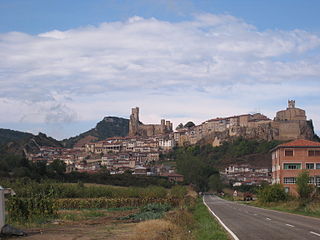
Frías is a town located in the northern part of the province of Burgos, in Castile and León, Spain. In 2010 it had a population of only 275 inhabitants.

The Diocese of Bilbao is a Latin Church diocese of the Catholic Church located in the city of Bilbao and Province of Biscay in Northern Spain. It is part of the ecclesiastical province of Burgos.

A trainera is a traditional boat of the Cantabrian Sea coast at the southern end of the Bay of Biscay, propelled by oars, and formerly sailing. It is a boat of fine lines with raised prow and rounded stern, to resist the waves of the Cantabrian sea. Traineras were originally used by fishermen to bring in the day’s catch of anchovies and sardines from sea to market, usually competing to sell their caught fish before others came in. Today, this historical tradition has become a major sport of coastal boat racing.

Pamplona Cathedral(Santa María de la Asunción) is a Roman Catholic church in the archdiocese of Pamplona, Spain. The current 15th century Gothic church replaced an older Romanesque one. Archaeological excavations have revealed the existence of another two earlier churches. The Neoclassical façade was designed by Ventura Rodríguez in 1783. It has a 13th-14th-century Gothic cloister that provides access to two other Gothic rooms: the Barbazan chapel and the refectory. The Mediaeval kings of Navarre were crowned and some also buried there. The Navarrese Cortes (Parliament) was held there during the early modern ages.
The Peace of Támara also known as the Pact of Támara was a peace treaty signed in Támara de Campos in June 1127 which delimited the territorial domains of Kings Alfonso I of Aragón and Alfonso VII of Castile.

Nuestra Señora de la Asunción is a Roman Catholic church in Bujalance, Andalusia, southern Spain.
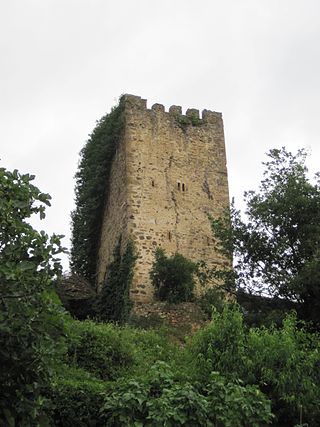
In Cantabria, there is a big number of fortified towers that fulfilled functions of housing and defense. These buildings, generally battlements, were erected mostly between the 13th and 15th centuries by noble families and influenced significantly in the architecture of Cantabria, passing some to be forts-houses, prelude to the future casona montañesa. A curious fact is that there are not in the region circular towers, as yes happens in the neighboring community of Asturias. Currently of the towers that survives several are in a deplorable condition.

The Hermandad of the Cuatro Villas de la Costa de la Mar, also cited under the name Cuatro Villas de la Costa de Cantabria, was a medieval and modern administrative entity that grouped the coastal cities of the north of the kingdom of Castile, all of them part of present-day Cantabria; namely, from west to east: San Vicente de la Barquera, Santander, Laredo, and Castro-Urdiales. At the end of the 15th century, it became part of the corregimiento of the Cuatro Villas along with other territories in the north of the Iberian Peninsula. In 1514 the province was renamed the corregimiento de las Tres Villas de la Costa, by separation from the town of San Vicente, which rejoined in 1521. Towns twinned since the 13th century, its foundation as a corregimiento dates back to the reign of the Catholic Monarchs, around 1496, surviving until its inclusion in the province of Cantabria in 1778.





